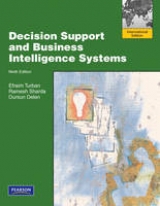
Decision Support and Business Intelligence Systems
Pearson (Verlag)
978-0-13-158017-6 (ISBN)
- Titel erscheint in neuer Auflage
- Artikel merken
Decision Support and Business Intelligence Systems 8e provides the only comprehensive, up-to-date guide to today's revolutionary management support system technologies, and showcases how they can be used for better decision-making. This completely revised and re-titled edition incorporates the expanded coverage of Business Intelligence and reflects the emphasis that most decision support courses are now taking.
Efraim Turban (M.B.A., Ph.D., University of California Berkeley) is a visiting scholar at the Pacific Institute for Information System Management, University of Hawaii. Prior to this he was on the staff of several universities including City University of Hong Kong, Lehigh University, Florida International University, California State University Long Beach, Eastern Illinois University, and the University of Southern California. Dr. Turban is the author of over 100 refereed papers published in leading journals such as Management Science, MIS Quarterly, and Decision Support Systems. He also the author of 20 books including Electronic Commerce: A Managerial Perspective andInformation Technology for Management. He is also a consultant to major corporations world wide. Dr. Turban’s current areas of interest are Web-based decision support systems, using intelligent agents in electronic commerce systems, and collaboration issues in global electronic commerce. Jay E. Aronson (M.S., M.S., Ph.D., Carnegie Mellon University) is a professor of Management Information Systems in the Terry College of Business at The University of Georgia. Prior to this he was on the faculty at Southern Methodist University. Dr. Aronson is the author of about 50 refereed papers that have appeared in leading journals including Management Science, Information Systems Research, andMIS Quarterly. He is the author of three books, and contributes to several professional encyclopedias. He is also a consultant to major international corporations and organizations. Dr. Aronson’s current areas of research include knowledge management, collaborative computing, and parallel computing. Ting-Peng Liang (MA, Ph.D., University of Pennsylvania) is a National Chair Professor of Information Systems at National Sun Yat-sen University in Taiwan and a visiting professor at Chinese University of Hong Kong. Prior to this, he had been on the faculties of University of Illinois (Urbana-Champaign) and Purdue University. Dr. Liang has published more than 50 referred research papers in leading journals such as Management Science, MIS Quarterly, Decision Support Systems, andJournal of MIS. He is also the author of three books and a consultant to several major companies in the United States and Taiwan. Dr. Liang’s current areas for research and teaching include Web-based intelligent systems, electronic commerce, knowledge management, and strategic applications of information technologies. Ramesh Sharda (MBA, Ph.D, University of Wisconsin-Madison) is Director of the Institute for Research in Information Systems (IRIS), ConocoPhillips Chair of Management of Technology, and a Regents Professor of Management Science and Information Systems in the Spears School of Business Administration at Oklahoma State University. He started and served as the Director of the MS in Telecommunications Management Program at OSU. Over 100 papers describing his research have been published in major journals including Management Science, Information Systems Research, Decision Support Systems, Journal of Management Information Systems, and many others. Dr. Sharda serves on several editorial boards including INFORMS Journal on Computing, Decision Support Systems, and Information Systems Frontiers. His current research interests are in decision support systems, collaborative applications, and technologies for managing information overload. Dr. Sharda is also a co-founder of a company that produces virtual trade fairs, iTradeFair.com.
Part I: Decision Support and Business Intelligence
1. Decision Support Systems and Business Intelligence
1.1 Opening Vignette: Toyota Uses Business Intelligence to Excel
1.2 Changing Business Environments and Computerized Decision Support
1.3 Managerial Decision Making
1.4 Computerized Support for Decision Making
1.5 An Early Framework for Computerized Decision Support
1.6 The Concept of Decision Support Systems (DSS)
1.7 A Framework for Business Intelligence (BI)
1.8 A Work System View of Decision Support
1.9 The Major Tools and Techniques of Managerial Decision Support
1.10 Implementing Computer-Based Managerial Decision Support Systems
1.11 Plan of the Book
1.12 Resources, Links, and the Teradata University Network Connection
Part II: Computerized Decision Support
2. Decision Making, Systems, Modeling, and Support
2.1Opening Vignette: Decision Making at the U.S. Federal Reserve
2.2 Decision Making: Introduction and Definitions
2.3 Models
2.4 Phases of the Decision Making Process
2.5 Decision Making: The Intelligence Phase
2.6 Decision Making: The Design Phase
2.7 Decision Making: The Choice Phase
2.8 Decision Making: The Implementation Phase
2.9 How Decisions are Supported
2.10 Resources, Links, and the Teradata University Network Connection
3. Decision Support Systems Concepts, Methodologies, and Technologies: An Overview
3.1 Opening Vignette: Decision Support System Cures for Healthcare
3.2 DSS Configurations
3.3 DSS Description
3.4 DSS Characteristics and Capabilities
3.5 Components of DSS
3.6 The Data Management Subsystem
3.7 The Model Management Subsystem
3.8 The User Interface (Dialog) Subsystem
3.9 The Knowledge-Based Management Subsystem
3.10 The User
3.11 DSS Hardware
3.12 DSS Classifications
4. Modeling and Analysis
4.1 Opening Vignette: "Winning Isn't Everything... But Losing Isn't Anything:" Professional Sports Modeling for Decision Making
4.2 MSS Modeling
4.3 Static and Dynamic Models
4.4 Certainty, Uncertainty, and Risk
4.5 MSS Modeling with Spreadsheets
4.6 Decision Analysis with Decision Tables and Decision Trees
4.7 The Structure of Mathematical Models for Decision Support
4.8 Mathematical Programming Optimization
4.9 Multiple Goals, Sensitivity Analysis, What-IF, and Goal Seeking
4.10 Problem Solving Search Methods
4.11 Simulation
4.12 Visual Interactive Simulation
4.13 Quantitative Software Packages and Model Base Management
4.14 Resources, Links, and the Teradata University Network Connection
Part III: Business Intelligence
Special Introductory Section: The Essentials of Business Intelligence
1.1 A Preview of the Content of Chapters 5-9
S.2 The Origins and Drivers of Business Intelligence
S.3 The General Process of Intelligence Creation and Use
S.4 The Major Characteristics of Business Intelligence
S.5 Towards Competitive Intelligence and Advantage
S.6 The Typical Data Warehouse and BI User Community
S.7 Successful BI Implementation
S.8 Structure and Components of BI
S.9 Conclusion: Today and Tomorrow
5. Data Warehousing
5.1 Opening Vignette: Continental Airlines Flies High with Its Real-Time Data Warehouse
5.2 Data Warehousing Definitions and Concepts
5.3 Data Warehousing Process Overview
5.4 Data Warehousing Architectures
5.5 Data Integration, and the Extraction, Transformation, and Load (ETL) Process
5.6 Data Warehouse Development
5.7 Real-Time Data Warehouses
5.8 Data Warehouse Administration and Security Issues
6. Business Analytics and Data Visualization
6.1 Opening Vignette: Lexmark International Improves Operations with BI
6.2 The Business Analytics Field-An Overview
6.3 Online Analytical Processing (OLAP)
6.4 Reporting and Queries
6.5 Multidimensionality
6.6 Advanced Business Analytics
6.7 Data Visualization
6.8 Geographic Information Systems
6.9 Real-Time Business Intelligence, Automated Decision Support, and Competitive Intelligence
6.10 Business Analytics and the Web: Web Intelligence and Web Analytics
6.11 Usage, Benefits, and Success of Business Analytics
7. Data, Text, and Web Mining
7.1 Opening Vignette: Highmark, Inc.
7.2 Data Mining Concepts and Applications
7.3 Data Mining Techniques and Tools
7.4 Data Mining Project Process
7.5 Text Mining
7.6 Web Mining
8. Neural Networks for Data Mining
8.1 Opening Vignette: Using Neural Networks to Predict Beer Flavors From Chemical Analysis
8.2 Basic Concepts of Neural Networks
8.3 Learning in Artificial Neural Networks
8.4 Developing Neural Network Systems
8.5 A Sample Neural Network Project
8.6 Other Neural Networks Paradigms
8.7 Applications of Neural Networks
8.8 A Neural Network Software Demonstration
9. Business Performance Management
9.1 Opening Vignette: Cisco and the Virtual Close
9.2 Business Performance Management Overview
9.3 Strategize: Where Do We Want to Go?
9.4 Plan: How Do We Get There?
9.5 Monitor: How are We Doing?
9.6 Act and Adjust: What Do We Need to Do Differently?
9.7 Performance Measurement
9.8 Bpm Methodologies
9.9 Bpm Architecture and Applications
9.10 Performance Dashboards
9.11 Business Activity Monitoring (BAM)
Part IV: Collaboration, Communication, Group Support Systems, and Knowledge Management
10. Collaborative Computing-Supported Technologies and Group Support Systems
10.1 Opening Vignette: Collaborative Design at Boein-Rocketdyne
10.2 Making Decisions in Groups: Characteristics, Process, Benefits, and Dysfunctions
10.3 Supporting Groupwork with Computerized Systems
10.4 Tools for Indirect Support of Decision Making
10.5 Integrated Groupware Suites
10.6 Direct Computerized Support for Decision Making: From GDSS to GSS
10.7 Products and Tools for GDSS/GSS and Successful Implementation
10.8 Emerging Collaboration Support Tools: From VoIP to Wikis
10.9 Collaborative Efforts in Planning, Design, and the Project Management
10.10 Creativity, Idea Generation and Computerized Support
11. Knowledge Management
11.1 Opening Vignette: Simens Knows What It Knows through Knowledge Management
11.2 Introduction to Knowledge Management
11.3 Organizational Learning and Transformation
11.4 Knowlege Management Activities
11.5 Approached to Knowledge Management
11.6 Information Technology in Knowledge Management
11.7 Knowledge Management Systems Implementation
11.8 Roles of People in Knowledge Management
11.9 Ensuring the Success of Knowledge Management Efforts
Part V: Intelligent Systems
12. Artificial Intelligence and Expert Systems
12. 1 Opening Vignette: Cigna Uses Business Rules to Support Treatment Request Approval
12.2 Concepts and Definition of Artificial Intelligence
12.3 The Artificial Intelligence Fields
12.4 Basic Concepts of Expert Systems
12.5 Applications of Expert Systems
12.6 Structure of Expert Systems
12.7 How Expert Systems Work- Inference Mechanisms
12.8 Problem Areas Suitable for Expert Systems
12.9 Development of Expert Systems
12.10 Benefits, Limitations and Success Factors of Expert Systems
12.11 Expert Systems on the Web
13. Advanced Intelligent Systems
13. 1 Opening Vignette: Improving Urban Infrastructure Management in the City of Verdum
13.2 Machine Learning Techniques
13. 3 Case-based Reasoning
13.4 Genetic Algorithms Fundamentals
13.5 Developing Genetic Algorithm Applications
13.6 Fuzzy Logic Fundamentals
13.7 Natural Language Processing
13.8 Voice Technologies
13.9 Developing Integrated Advanced System
14. Intelligent Systems over the Internet
14.1 Opening Vignette: NetFlix Gains High Customer Satisfaction from DVD Recommendation
14.2 Web-Based Intelligent Systems
14.3 Intelligent Agents: An Overview
14.4 Characteristics of Intelligent Agents
14.5 Why Use Intelligent Agents
14.6 Classification and Types of Intelligent Agents
14.7 Internet-Based Software Agents
14.8 DSS Agents and Multi-agents
14.9 Semantic Web: Representing Knowledge for Intelligent Agents
14.10 Web-Cased Recommendation Systems
14.11 Managerial Issues of Intelligent Agents
Part VI: Implementing Decision Support Systems
15. Systems Development and Acquisition
15.1 Opening Vignette: Osram Sylvania Thinks Small, Strategizes Big- Develops the InfoNet HR Portal System
15.2 What Types of Support Systems Should We Build?
15.3 The Landscape and Framework of MSS Applications Development
15.4 Development Options for MSS Applications
15.5 Prototyping: A Practical MSS Development Methodology
15.6 Criteria For Selecting a Development Approach
15.7 Third-Party Providers of MSS Software Packages and Suites
15.8 Connecting to Databases and Other Enterprise Systems
15.9 Rise of Web Services, XML, and Service-Oriented Architecture
15.10 End-user Developed MSS
15.11 Vendor and Software Selection and Management
15.12 Putting the MSS Together and Implementation Issues
16. Integration, Impacts, and the Future of Management Support Systems
16.1 Opening Vignette: Elite-Care Supported by Intelligent Systems
16.2 Systems Integration: An Overview
16.3 Types of MSS Integration
16.4 Integration with Enterprise Systems and Knowledge Management
16.5 The Impacts of MSS: An Overview
16.6 MSS Impacts on Organizations
16.7 MSS Impacts on Individuals
16.8 Automating Decision Making and the Manager's Job
16.9 Issues of Legality, Privacy, and Ethics
16.10 Intelligent and Automated Systems and Employment Levels
16.11 Other Societal Impacts and the Digital Divide
16.12 The Future of Management Support Systems
16.13 Resources, Links, and Teradata University Connection
| Erscheint lt. Verlag | 3.4.2008 |
|---|---|
| Sprache | englisch |
| Maße | 204 x 255 mm |
| Gewicht | 1356 g |
| Themenwelt | Wirtschaft ► Betriebswirtschaft / Management |
| ISBN-10 | 0-13-158017-5 / 0131580175 |
| ISBN-13 | 978-0-13-158017-6 / 9780131580176 |
| Zustand | Neuware |
| Haben Sie eine Frage zum Produkt? |
aus dem Bereich



